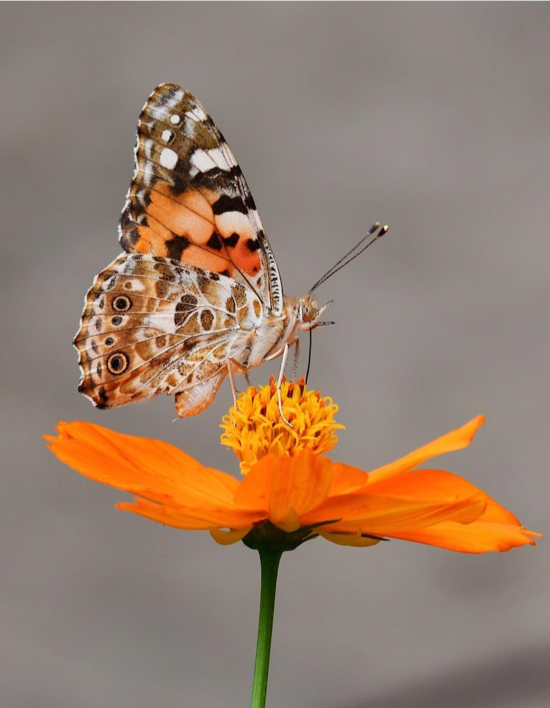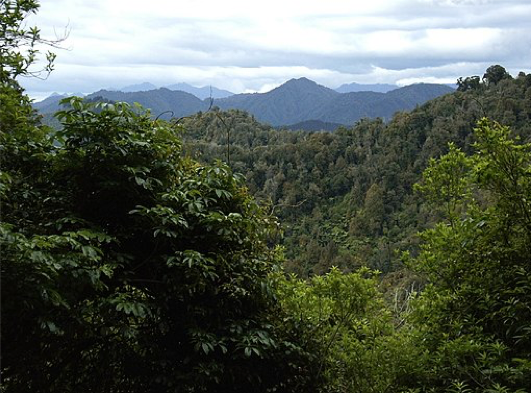Pollinators Need Rights, Too
Figure 1 Photo by Krzysztof Niewolny on Unsplash
By Andrea Egert
Whether tiny and cute, pretty and flitty, or hairy and scary, our world’s insects are anything but least among us. Insects outnumber each human 200 million to one. It’s estimated that our planet holds 300 pounds of insects for every single pound of human. At any given time, there’s about ten quintillion (10,000,000,000,000, 000,000) individual insects alive on earth.
Insects Are Important, and They’re Disappearing
Insect species dominate compositional diversity and contribute to the maintenance of terrestrial and freshwater systems everywhere. So far, 1 million species of insects have been described by scientists, while at least 4 million species are still unrecorded. A recent study, however, projected the extinction of as much as 40% of the earth’s insect species over the next few decades.
To add to concerns, a summary of the United Nations’ global assessment report on biodiversity and ecosystem services shows that Nature’s overall role in ecological and evolutionary processes that distribute fresh water, regulate climate, support pollination, control pests, and limit the impacts of natural hazards all face an overall decline for biodiversity and ecosystems due to human-induced changes involving farming, climate change and global warming, and fishing. This summary urges recognition of the intrinsic values of Nature’s contributions to people. Pollinator loss, in particular, is cited as a particular risk leading to tremendous losses in annual global crop output, placing global human food supplies at risk.
Figure 2 Hummingbird from Pexels.com
There is no doubt among a multitude of scientists, lawmakers, and citizens here in the United States that swift and effective conservation and protection efforts for insect species are acutely needed. In response, laws have been enacted, plans have been made, and concerned Americans have been engaging in both random and organized acts of citizen science everywhere across the four major regions of the US—Northeastern, Southern, Midwestern, and Western. Much of the focus has been on protection of pollinators due to their essential role in plant life and food production.
Pollinating insects contribute to 1 of every 3 bites we eat, and 90 percent of the world’s flowering plants depend upon pollinators to reproduce. Pollinating insects include honeybees, native bees, butterflies, ants, and numerous other insects, and pollinating animals include birds, bats, and lizards. Bees pollinate 30% of the world’s crops. Maintaining the health of pollinators has become a growing focus of state legislatures, with 22 states having already enacted pollinator-protective legislation in recent years.
Threats to pollinators
Sources of distress in pollinating insects include habitat loss, disease, pathogens, pests, competition for non-native plant species, non-target effects of chemicals, climate change and—in the case of bees—colony collapse.
Awareness of pollinators and the urgent need for their legal protection is critical, as the ongoing decline of pollinator populations in many regions threaten ecosystems and human food supplies and occur at a range of scales. Such declines have been shown to involve pressures such as disease and pesticides, and biological processes such as species dispersal and interactions.
And with National Pollinator Week having been designated by the U.S. Senate to take place in June, it’s a great time to consider the multitude of year-round projects — scaling both large and small—that protect pollinators, showing that humans across the country are actively supporting pollinators in their foundational role of supporting life on earth.
Pollinator Protection in the Northeastern United States
The variety of projects throughout the US supporting and protecting pollinators range in both size and scope, and beekeeper Ray Sage presents an example of individual commitment to a community-based project protecting pollinators, maintaining colonies of honeybees on the roof of the Sixth Street Community Center in his East Village neighborhood in New York City.
Figure 3 Sixth Street Community Center. Beyond My Ken
Sage’s interest in keeping native honey bees began about 8 years ago with taking courses and placing two hives on the community center’s roof. Sage says that his concern with sustainability led him to raise native honey bees because “they are integrated into their own environment—raised with the plants in their region, symbiotically serving the plants that they live with.” Over the years, he has experienced both the expansion and decline of the colonies he has tended, supporting as many as 5 colonies at one time.
Sage and his bees have contended with challenges that are normal for beekeeping in the Northeastern latitude involving seasonal temperature shifts, but they have also confronted threats that have been diminishing populations of honey bees throughout the world in recent years. Parasitic Varroa mites have become a common threat to the hives of beekeepers everywhere by vectoring viruses to honey bee colonies and they were a big problem for Sage’s bees.
Sage’s honey bees have a 3-mile radius for feeding, and have also been subject to a dearth of available pollen and nectar during the summer. Sage has had to skip collecting honey so that the bees can adequately feed for overwintering. He also considers how neonicotinoid pesticides have contributed to the decline of the honey bee colonies he has kept. These pesticides can be carried in a flower’s pollen and are banned in Europe.
In the Northeast, many people are taking time to get directly involved in pollinator monitoring, support, and protection efforts. Organized projects that utilize citizen science, where individuals monitor pollinators and collect and report data for habitat management, informing public policy, increasing public awareness, and conservation planning, are underway.
Also based in New York City, the Great Pollinator Project facilitates public participation in pollinator research. In upstate New York, the Adirondack Pollinator Project has promoted the planting of pollinator-supporting plants and gardens, as well as education and conservation projects.
Pollinator protection projects can also be found in many Northeastern cities on a neighborhood-focused, city-wide, and state-wide basis, including the Portland Pollinator Project in Portland, Maine, and the Audubon Society’s chapters in Rhode Island and New Hampshire.
Southern United States:
Pollinator gardens and plantings using pesticide-free and pollen and nectar-rich native plants are a great way to increase habitats and waystations that sustain pollinators, either right in one’s own backyard or even in one’s own window box.
Bee City USA is a pollinator-protecting initiative of the diversity-promoting Xerces Society for Invertebrate Conservation, and participating cities throughout the Southern United States include Eureka Springs AR, Webster FL, Atlanta GA, Clarkson KY, Crestwood MO, Asheville NC, Greenwood SC, Bell Buckle TN, Scottsville VA, among many other cities and towns in these states that are committed to creating sustainable habitats for pollinators.
Of course, Beeville TX has done its part to create and maintain habitats for bees and other pollinating insects, and it’s home to a recognized monarch waystation. And a host of gardens throughout the South are registered and counted in the National Pollinator Gardens nationwide Million Pollinator Garden Challenge.
Midwestern United States:
In the Midwest, concern over pollinator decline due to habitat loss has spurred projects in states like Ohio, home of the Ohio Pollinator Habitat Initiative, which focuses on the improvement of existing habitats as well as habitat creation.
Figure 4 Photo by Yuichi Kageyama on Unsplash
In Indianapolis, Indiana, city residents take action with a 4-minute-long pollinator count to increase wild pollinators and biodiversity in local communities and neighborhoods. In Illinois, Missouri, Ohio, and Indiana, Beespotter citizen scientists can collect and share data with the professional science community and contribute to a nationwide effort on the population status of honey bees and bumble bees.
Butterflies are also critically important pollinators, and declining butterfly populations have necessitated long-term efforts in butterfly conservation. Monarch butterflies, for example, are the official insect or butterfly of seven U.S. states but, since 1999 and well into the 21st century, overwintering colonies of monarchs have experienced decline in Mexico and California due to declining milkweed, their favorite plant, from expanded farming of herbicide-tolerant, genetically modified corn and soybeans. People, nevertheless, are continually fascinated by both the monarchs’ lifecycle and its complex migratory cycle.
One study considering market-based conservation practices suggested that the majority of U.S. households believe that monarchs and their conservation are important, and this study also considered how the charismatic monarch’s perceived valuation and persistent popularity, despite general human perception of insects being less valuable than animals, may reflect a general interest in protection of pollinators overall.
In the Midwest, Minnesota is home-base for Monarch Joint Venture, a national partnership of over 80 organizations across the US that includes federal agencies, local nature centers, and “everything in between” according to Cora Lund Preston, its Communications Specialist. She goes on to say that “we see monarchs as both a flagship and ambassador species that is beloved by people of all walks of life, generating interest in general pollinator conservation. Whatever we do for monarchs can help other pollinators, too.”
Figure 5 Swamp Milkweed. By Fritzflohrreynolds - Own work
The first step for anyone interested in supporting monarchs and pollinators? “Plant milkweed!” Lund Preston enthusiastically recommends. She explains “You don’t need much space to plant a small milkweed and butterfly garden that feeds pollinators.
Planters, home gardens, corporate campus landscaping, even farm fields and roadside gardens featuring both milkweed and native flowering plants are popping up everywhere, and they become way-stations and habitats that provide nectar and pollen for monarch caterpillars, adult monarch butterflies, and many other pollinators.”
Sometimes, milkweed plants will show up on their own, and Lund Preston emphasizes that if you suddenly notice a milkweed plant proudly appearing in your yard, resist the urge to treat it as a must-to-remove weed—instead, honor its monarch and pollinator-sustaining presence by remembering this rule: “If you see it, leave it!” She also recommends spreading the word by encouraging friends, neighbors, and other community members to plant pollinator planters and gardens of their own.
Citizen science, Lund Preston points out, can be the next step once pollinator-supporting plants are established, emphatically stating that “a lot of what we know is thanks to citizen science—it’s an important way for people across the country to get involved in pollinator conservation.” Here’s a few examples of citizen science projects that Monarch Joint Venture and its partners host. People can choose the program that interests them most, and they can submit observations from anywhere in the US:
Level 1: Random Reporting - You can report a random sighting at Journey North, one of the largest citizen science programs in the North America based at University of Wisconsin - Madison Arboretum.
Level 2: Regular Monitoring - Visit a patch weekly and report findings at the University of Minnesota’s Monarch Larva Monitoring Program.
Level 3: Extended Monitoring - Habitat monitoring and observation reporting over time at Monarch Joint Ventures’ Integrated Monarch Monitoring Program
Southwestern, Western, and Northwestern States:
Gail Morris, Coordinator of the Arizona-based Southwest Monarch Study and Monarch Watch Conservation Specialist, also describes the value of citizen science at any level in monarch monitoring programs, saying “Many people choose to only tag monarchs on their migration, so that is one way they can participate as a Citizen Scientist. Others choose to also monitor milkweed weekly to observe eggs, larvae, pupae, and send in weekly reports. And some will chose to do both. We try to meet people where they are and welcome their involvement and time commitments.”
Figure 6 Sunflowers. Photo by Todd Trapani on Unsplash
Morris also remarks upon the value of citizen science-based fieldwork in recording and demonstrating how summer of 2018 was a good breeding year for monarchs East of the Rockies, but the data also showed how monarch numbers along the coast of California were the lowest in US recorded history. Morris describes how, this year, data captured by citizen scientists show an increase in the size of monarch populations as they recolonize North America. She recommends Monarch Watch as another national program registering and collecting citizen science-obtained data recording the dynamics of monarch populations.
Based at the University of Arizona, Nature’s Notebook allows registered participants to observe and report the flowering timing of nectar sources for monarchs and other pollinators through the Nectar Connectors campaign. Participants can even use a smartphone app to upload data to the National Phenology Database from anywhere in the US.
San Francisco State University is home to the Great Sunflower Project, where citizen science data is used for monitoring national bee pollinator service and where counts of the numbers and types of pollinators are kept, as well as monitoring of the types of flowering plants they visit— especially sunflowers.
And in Seattle, Washington, the Northwest Pollinator Initiative’s CSI:Bees (Citizen Science Initiative for Bees) utilizes short courses and collaborative bee monitoring efforts for wild bee conservation.
Earth Law’s Critical Role
Beekeeper Ray Sage in New York City’s East Village describes his commitment to maintaining the hives as a recognition of the bees’ valuable role as life sustaining pollinators. His holistic view of ecosystems is consistent with a Rights of Nature approach. Support for the inherent rights of all creatures and ecosystems is a guiding principal for Sage, who remarks that support of biodiversity “is the essence of Nature’s law and sustainability” and who concludes “I maintain these hives as an act of service.”
A growing global movement, Earth Law holds that Nature and species have a right to exist, thrive and evolve. In addition to Ecuador and Bolivia which recognized Rights of Nature in 2008 and 2011 respectively, the Whanganui became the first river to gain rights recognition in 2017. The dormant volcano Mount Taranaki, also in New Zealand gained rights a few months later in 2017. The heavily forested National Park Te Urewera also has legal rights.
Figure 7 Te Urewera, New Zealand. I, Brucieb
In the US, the city of Crestone unanimously passed a Rights of Nature Resolution in 2018 thus joining dozens of municipalities that have also passed ordinances and resolutions. Earth Law Center launched over two dozen initiatives in the US and around the world to support local partners to secure rights recognition for Nature.
The holistic view of Earth Law prioritizes the health and balance of ecosystems, including pollinators. Rights of Nature advocates looking at Nature as something precious to preserve rather than as a limitless resource to take – which can prevent the wholesale destruction of Nature that removes whole habitats, thus wiping out the species who live there.
Our lives depend on the lives of pollinators, whether we think about them or not. Moving towards a new way of looking at Nature and of relating to Nature offers an innovative solution to the environmental crisis we face today. Won’t you join us by taking action today?







